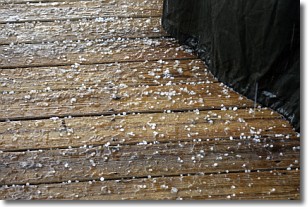Weather Alert in Arizona
Red Flag Warning issued May 12 at 9:12PM MST until May 13 at 7:00PM MST by NWS Flagstaff AZ
AREAS AFFECTED: Chuska Mountains and Defiance Plateau; Little Colorado River Valley in Coconino County; Little Colorado River Valley in Navajo County; Little Colorado River Valley in Apache County; White Mountains
DESCRIPTION: MST Mon May 12 2025/ ...RED FLAG WARNING REMAINS IN EFFECT FROM 11 AM MST /NOON MDT/ TO 7 PM MST /8 PM MDT/ TUESDAY FOR THE WHITE MOUNTAINS NORTHWARD TO THE CHUSKA MOUNTAINS... * AFFECTED AREA...Locations near Alpine, Buffalo Pass, Eagar- Springerville, Ganado, Holbrook, Pinetop-Lakeside, Saint Johns, Show Low, Snowflake-Taylor, Tuba City, Whiteriver, Window Rock and Winslow. This includes portions of the Apache- Sitgreaves National Forest. * WINDS...Southwest 30 to 40 mph with gusts up to 70 mph. * RELATIVE HUMIDITY...As low as 9 percent. * IMPACTS...The combination of gusty winds and low humidity can cause fires to rapidly grow in size and intensity before first responders can contain them.
INSTRUCTION: A Red Flag Warning means that critical fire weather conditions are either occurring or are imminent. A combination of strong winds and low relative humidities can contribute to extreme fire behavior. Please notify field crews of this Red Flag Warning.
Want more detail? Get the Complete 7 Day and Night Detailed Forecast!
Current U.S. National Radar--Current
The Current National Weather Radar is shown below with a UTC Time (subtract 5 hours from UTC to get Eastern Time).

National Weather Forecast--Current
The Current National Weather Forecast and National Weather Map are shown below.

National Weather Forecast for Tomorrow
Tomorrow National Weather Forecast and Tomorrow National Weather Map are show below.

North America Water Vapor (Moisture)
This map shows recent moisture content over North America. Bright and colored areas show high moisture (ie, clouds); brown indicates very little moisture present; black indicates no moisture.

Weather Topic: What is Rain?
Home - Education - Precipitation - Rain
 Next Topic: Shelf Clouds
Next Topic: Shelf Clouds
Precipitation in the form of water droplets is called rain.
Rain generally has a tendency to fall with less intensity over a greater period
of time, and when rainfall is more severe it is usually less sustained.
Rain is the most common form of precipitation and happens with greater frequency
depending on the season and regional influences. Cities have been shown to have
an observable effect on rainfall, due to an effect called the urban heat island.
Compared to upwind, monthly rainfall between twenty and forty miles downwind of
cities is 30% greater.
Next Topic: Shelf Clouds
Weather Topic: What is Sleet?
Home - Education - Precipitation - Sleet
 Next Topic: Snow
Next Topic: Snow
Sleet is a form of precipitation in which small ice pellets are the primary
components. These ice pellets are smaller and more translucent than hailstones,
and harder than graupel. Sleet is caused by specific atmospheric conditions and
therefore typically doesn't last for extended periods of time.
The condition which leads to sleet formation requires a warmer body of air to be
wedged in between two sub-freezing bodies of air. When snow falls through a warmer
layer of air it melts, and as it falls through the next sub-freezing body of air
it freezes again, forming ice pellets known as sleet. In some cases, water
droplets don't have time to freeze before reaching the surface and the result is
freezing rain.
Next Topic: Snow
Current conditions powered by WeatherAPI.com




